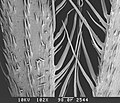Foxtail (diaspore)
This article needs additional citations for verification. (December 2023) |

A foxtail is a
and a nuisance for people.Sources
The name "foxtail" is applied to a number of grasses that have bushy
Grasses known as foxtails include:
- Alopecurus (foxtail grasses — the scientific name literally means "fox tail")
- Bromus madritensis (foxtail brome)
- Hordeum jubatum (foxtail barley)
- Setaria (foxtail millets)
Other grasses also produce hazardous spikelets. The spikelets are sometimes called foxtails, even though the grasses are not.
Structure
All foxtails have a hardened tip, sometimes called a "callus", and
The spikelets or spikelet clusters of foxtails are adapted for animal dispersal: The foxtails disarticulate easily, the barbs cause the foxtail to cling to fur, and movement of the animal causes the foxtail to burrow into the fur, since the barbs permit it to move only in the direction of the callus. In wild mammals that inhabit the native ranges of foxtail grasses, the fur is ordinarily short enough that the foxtails will eventually become dislodged, dispersing the seed.
Hazard
Foxtails can become a health hazard for pets and other domestic animals, and a nuisance for people.
In dogs, cats, and other domestic animals the foxtails can become irreversibly lodged. Foxtails can also enter the
Foxtails are a problem beginning when the grass
Foxtails that have progressed no further than surface
Combing of fur removes foxtails along with burrs and other detritus, but potentially the most dangerous foxtails are found in areas easily missed: the axillae, between the toes, and in nostrils and ear canals. Occasionally they can even lodge in the conjunctiva under the eyelid.
Many wild barley species are weeds in disturbed habitats, and their growth is encouraged by foot traffic of humans and domestic animals. Control methods consist of restricting traffic to established paths, and eradication of wild barley by mechanical removal or herbicide. Some other foxtail-producing grasses, especially needlegrasses, are dominant species in stable grassland habitats. Control attempts in these cases can actually be counterproductive, creating disturbed habitats where wild barleys may thrive.
Gallery
-
The spike of Hordeum murinum disarticulates into clusters of three spikelets
-
Each spikelet cluster is held together by a portion of the rachis
-
Spikelet cluster viewed by scanning electron microscope
-
The rachis segment, sometimes called a "callus", is hardened, and covered with retrorse barbs
-
Rachis segment viewed by scanning electron microscope. Note the retrorse barbs on both the rachis and the pedicels.
-
Retrorse barbs on lemma.
-
Retrorse barbs and trichomes on lemma.






